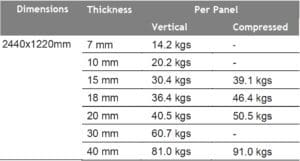Data Sheet - Plantation Bamboo Panels (Vertical & Compressed)
Plantation Bamboo panels are a stunning alternative to hardwood products and plywood. The success of the product lies in its fantastic strength, sustainability, great looks, and amazing versatility.
Bamboo panels are ideal for any wooden application, from bench tops to cabinets, kitchen joinery to furniture, stunning staircases (including treads, risers, stringers and handrails) to doors, and much more – both in the residential or commercial environment.

Structure and Lamination
The outside surface of the vertical bamboo panel is manufactured using vertical strips of bamboo laminated together, giving a uniform, stripe look. The grain runs along the longest length of the panel.
Compressed bamboo panel’s outer layers (top and bottom) are made from compressing the bamboo fibres at huge pressure, which gives a harder, more dense surface (similar to compressed bamboo flooring).
Bamboo panels are cross laminated into either 3 or 5 ply, to ensure long lasting stability and durability. The 7, 10, 15, 18, 20, 30mm – cross laminated into 3 ply; 40mm – cross laminated into 5 ply.
Colour
Panels are available in Natural and Coffee colours.
Panel Dimensions and Weight

Grading
The bamboo panels are graded for colour, thickness and sizing, to ensure a consistent, uniform product. However being a natural product, some colour/tone variations may exist. Product meets AA standard.
Bending Strength (Vertical Panels)
(tested by Scion, 13 May 2014)
100x30mm vertical bamboo gross section bending strength and stiffness properties:

Material
Made from 100% Phyllostachys Pubescens (common name: Moso Bamboo) harvested at maturity at 5-6 years for maximum fibre density, with Prefere 6121 adhesive. Plantation Bamboo panels fall well below E1 requirements for VOC (Volatile Organic Compound) levels *MSDS available.
The inner layers of the bamboo panels consist of multiple, separated cross segments, which can create some small voids in these layers. This construction optimizes the stability of the panels. The voids may need to be filled during processing and finishing.
The surface of the compressed panels may contain small seams and open pores. Depending on the finishing and customer requirements, the surface can be closed using a (colour matching) filler, or by using sanding dust with a clear wood glue.
Plantation panels have an A and B side. The backside (B) generally contains more colour variation than the surface side (A) and can show small seams between the strips. The backside should be marked with a pencil line or sticker.
Cutting and Tooling
Bamboo cuts and tools well with standard woodworking tools. Sharp carbide tipped tools are recommended. When cross-cutting, the higher the saw tooth count the better. A very high ATB blade works best. Bamboo machines easily with the grain.
Just as plywood does, bamboo can splinter when cross-cutting across the end grain. Due to the linear fibrous nature of bamboo, do not try to snap off these small pieces – cut them or sand them off. Pulling the bamboo fibres could cause them to ‘run’ along the length of the grain. Profiles can be easily routed. Bamboo sands well with any standard woodworking sander.
Fastening
Pilot holes, pre-drilling oversized slots for screw inserts, panel clips or other methods that allow for expansion and contraction are necessary.
While the bamboo panels are very strong, they should be well fastened/supported to avoid bending.
Just as plywood does, bamboo can splinter when cross-cutting across the end grain. Due to the linear fibrous nature of bamboo, do not try to snap off these small pieces – cut them or sand them off. Pulling the bamboo fibres could cause them to ‘run’ along the length of the grain. Profiles can be easily routed. Bamboo sands well with any standard woodworking sander.
Finishing
Plantation Bamboo Panels are supplied unfinished. After fabrication, all exposed surfaces and edges must be covered and finished with at least two coats of suitable oil, polyurethane or lacquer to protect them from water penetration and moisture.
Advised room temperature/conditions: 18-24oC; air humidity 40-60%.
Warranty
Plantation Bamboo panels are warranted against delamination, and will not separate as a result of a manufacturing defect for a period of 15 years from the date of sale.
Other Technical Information
– Density (Top Layer): +/- 700 kg/m3 (v); +/- 1050 kg/m3 (c)
– Top layer thickness/ Wear layer: 3.5-5mm (v); 3-4mm(c) *1
– Resistance to indentation – Brinell Hardness:: > 4 kg/mm2 (v);
> 9.5 kg/mm2 (c) (EN 1534)
– Reaction to fire: Class D-s1-dO *2 (EN13501-1)
– Equilibrium Moisture Content: 9-12% at 65% relative humidity, 20 degrees Celsius
– Shrink/Swell bamboo: 0.14% per 1% change in moisture content
– Glue: D3 water resistant
– Environmental Product Declaration – EPD (EN 15804) (www.moso.eu/epd)
– CO2 neutral: LCA report TU Delft (ISO14040/44 (www.moso.eu/lca)
– Formaldehyde emission: Class E1 (< 0.124mg/m3, EN 717-1)
/Class E0 (0.025 mg/m3) *3
– Modulus of Elasticity: 4530 N/mm2 (40mm) *4 (mean value – EN 789)
– Contribution LEEDBD+C–v4:MR 1, MR 2,MR3(FSC),EQ2
v2009: MR 6, MR 7 (FSC), IEQ 4.4 (if requested as E0)
– Contribution BREEAM: HEA 2, MAT 1, MAT 3(FSC) (v); MAT 5) (c)
(v) = vertical bamboo panel
(c) = compressed bamboo panel
*1 – depending on thickness version
*2 – tested on 40mm panel, with ventilation space between boards
*3 – available on request – EO class is an unofficial formaldehyde emission class, but it is commonly used to indicate that the product is produced with No Added Formaldehyde (NAF) glues. EO products automatically qualify for the official E1 class according EN 717-1
*4 – modulus of Elasticity of other panels available on request.
Please note that all values are averages unless otherwise stated, and should not be used for calculations in structural applications. For assistance in planning structural projects, please contact Plantation Bamboo directly.

